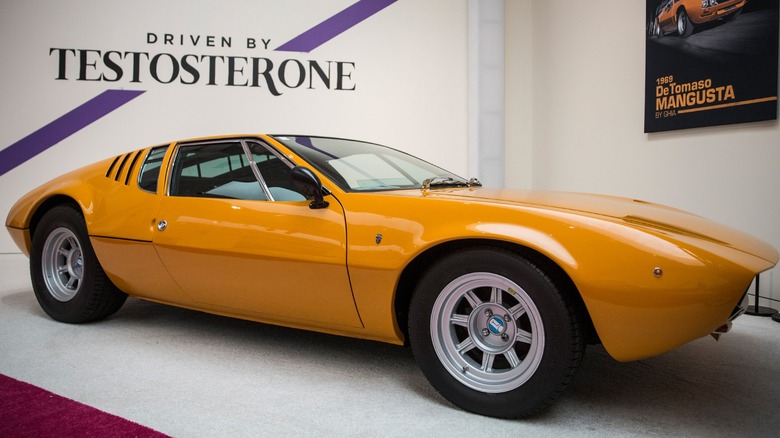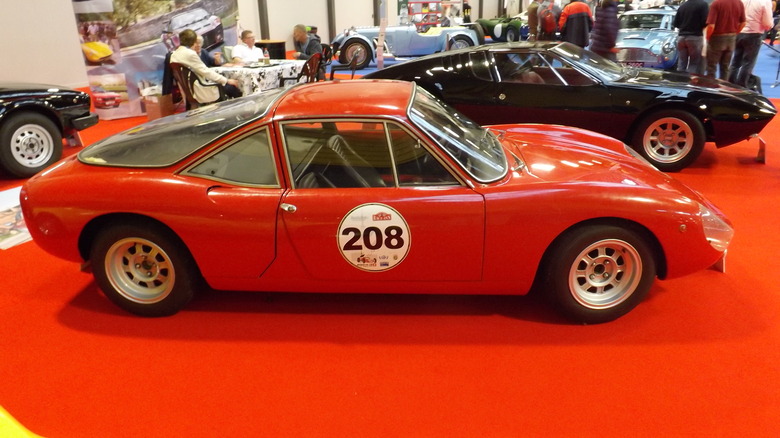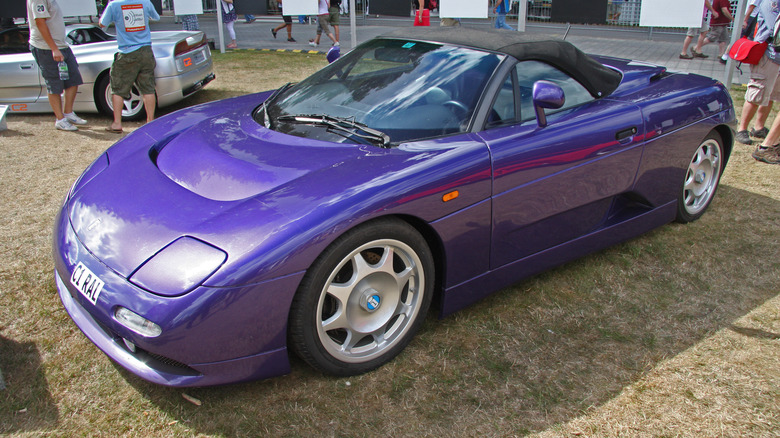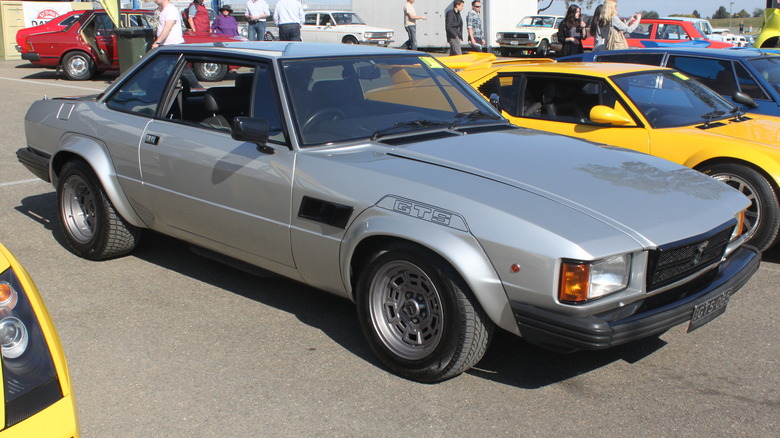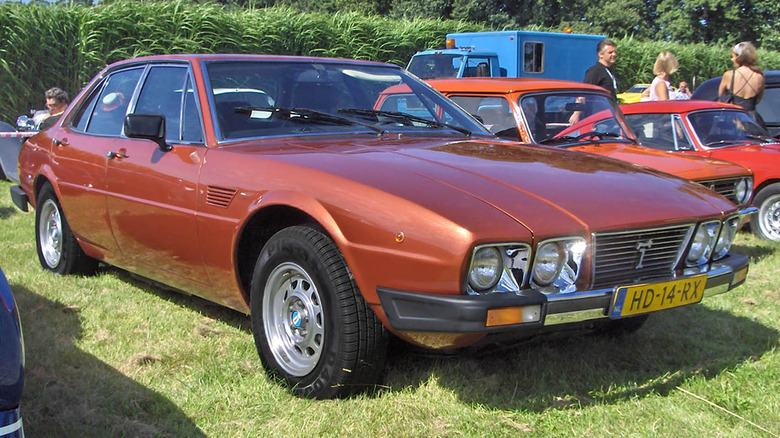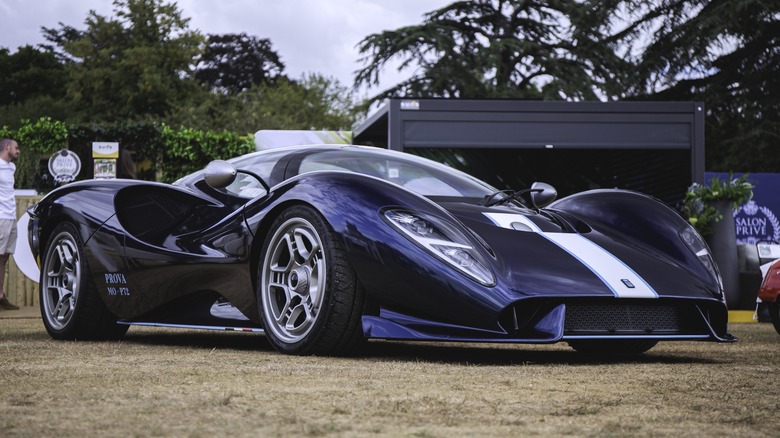5 Incredible De Tomaso Models You Probably Didn't Realize Exist
In the history of luxury performance car manufacturing, De Tomaso is a bit of an underdog. The company was started in the 1960s by Alejandro De Tomaso, an Argentinian rancher who had a fascination with racing and cars from a very young age. Though it may not be the first name to come to mind when you think of high-performance vehicles from the 1960s, '70s, and '80s, De Tomaso still deserves to be a part of that conversation
The De Tomaso Pantera is the car that truly put the company on the map — one of the coolest European supercars with an American engine. It was a low-roofline mid-engine supercar with a 351 cubic-inch Ford V8. The program was so closely tied to Ford, in fact, that the cars were sold via Ford's Lincoln-Mercury dealerships for a time. While the Pantera is certainly the most famous De Tomaso model, it's far from the only one. Let's take a look at some of the other cars that helped build the company.
The original De Tomaso Vallelunga
De Tomaso came out swinging with the release of its first production road car, the Vallelunga. Prior to its release, De Tomaso was strictly a low-volume manufacturer of race cars for Formula Junior, Formula 3, Formula 2, and Formula 1.
The Vallelunga was one of the first mid-engine road cars made for sale to the public, and it reflected the company's relationship with Ford well before the release of the Pantera. The Vallelunga used a 104 horsepower four-cylinder engine sourced from the Ford Cortina, and it used a Volkswagen transaxle to mount it in the middle of the chassis behind the cockpit.
It had plenty of modern handling attributes like double wishbone suspension, coilover spring/damper assembly, and anti-roll bars. It even had disc brakes all around. It used a fiberglass body to keep it nice and lightweight, and that goal was certainly achieved, as it came in at only 1,600 pounds.
[Featured image by Andrew Bone via Wikimedia Commons | Cropped and scaled | CC BY-SA 2.0]
The final De Tomaso: The Guara
In 1993, Alejandro De Tomaso had a stroke, and his resulting health issues led him to hand off the operations of the company. Before he did, though, he created what would become the last De Tomaso road car: the Guara.
The Guara is a mid-engine sports car based on the Maserati Barchetta Stradale prototype. It was available in coupe, convertible, and even a full open-top racecar-inspired variant. Power initially came from a BMW V8 engine. Despite remaining in production for ten years, only around 50 models of the car were ever built. In 1998, De Tomaso switched to yet another Ford engine with the 4.6-liter 32-valve V8 from the Ford Mustang Cobra.
As with the original Vellelunga, the Guara was focused on performance handling. With a sub-five-second zero-to-60 MPH time and a mid-engine layout, the Guara was an appropriate note on which the classic De Tomaso legacy could end.
[Featured image by Brian Snelson via Wikimedia Commons | Cropped and scaled | CC BY-SA 2.0]
The De Tomaso Longchamp
While the mid-engine two-seater layout is definitely a De Tomaso staple, the Longchamp stands out as a sort of middle ground between a high-performance sports car and a usable daily driver. It's still a two-door coupe, but it also has two rear seats. It was built to compete with the Aston Martin DBS, the Ferrari 365 GT4 2+2, and the Jensen Interceptor.
Instead of a mid-engine layout, the Longchamp used an FR layout, meaning the engine was up front while power was sent to the rear. Like the Pantera, the Longchamp used a 351 cubic-inch Ford V8 engine and was solely available with a three-speed automatic transmission. With 330 horsepower on tap, it offered plenty of grunt for the time.
Don't get your hopes up on tracking one of these cars down, though. According to Hagerty, De Tomaso claimed that only 410 Longchamps were produced. However, gaps in chassis production numbers imply that the company may not have actually produced that many.
[Featured image by Jeremy via Wikimedia Commons | Cropped and scaled | CC BY-SA 2.0]
The Deauville sedan
Like the Longchamp, the Deauville was a departure from the De Tomaso high-performance sports car formula. It was even further removed from that pedigree, however, because it was a four-door sedan. The Deauville goes hand-in-hand with the Longchamp in that it took aim at other luxury and performance GT cars from Ferrari, Lamborghini, and Aston Martin. That isn't where the similarities end, either.
The Deauville also used the Ford 351 Windsor V8 engine found in the Longchamp, and like the Longchamp, it was available only with the three-speed Ford automatic transmission. It still used double wishbone independent suspension all around with accompanying disk brakes. So, despite its practicality, it still had plenty of performance flavor on tap. As with the Longchamp, the chassis production numbers are a little funky compared to De Tomaso's claimed official production number of 240. In reality, it's suspected that around half that number was actually produced.
[Featured image by Deauville81 via Wikimedia Commons | Cropped and scaled | Public Domain]
De Tomaso returns: The P72
Nearly twenty years after the final production Guara, De Tomaso made a triumphant return under new ownership from Hong Kong's Ideal Team Ventures. To pay homage to the legendary P70 racecar, the company ordered production for a limited-run supercar – the P72. It's a blend of historic De Tomaso style and modern design and engineering.
Once again, the company turned to Ford for power, using a Roush–tuned supercharged Ford 5.0L Coyote V8 engine with 700 horsepower and 608 pound-feet of torque. It's mid-engine, of course, and available exclusively with a six-speed manual transmission.
As suggested by the name, only 72 models were announced to be in production. With a starting price of $794,000, the pool of potential owners is pretty small. In 2023, Hemmings reported that De Tomaso is working on an even more hardcore variant called the P900 with either V10 or V12 power. Only 18 of those will be made, reportedly, and they're expected to cost north of $3 million.
